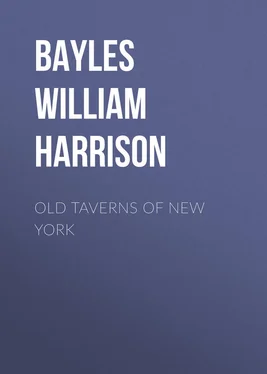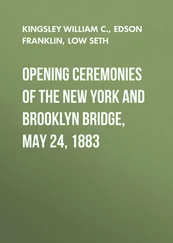William Bayles - Old Taverns of New York
Здесь есть возможность читать онлайн «William Bayles - Old Taverns of New York» — ознакомительный отрывок электронной книги совершенно бесплатно, а после прочтения отрывка купить полную версию. В некоторых случаях можно слушать аудио, скачать через торрент в формате fb2 и присутствует краткое содержание. Жанр: foreign_antique, foreign_prose, на английском языке. Описание произведения, (предисловие) а так же отзывы посетителей доступны на портале библиотеки ЛибКат.
- Название:Old Taverns of New York
- Автор:
- Жанр:
- Год:неизвестен
- ISBN:нет данных
- Рейтинг книги:3 / 5. Голосов: 1
-
Избранное:Добавить в избранное
- Отзывы:
-
Ваша оценка:
- 60
- 1
- 2
- 3
- 4
- 5
Old Taverns of New York: краткое содержание, описание и аннотация
Предлагаем к чтению аннотацию, описание, краткое содержание или предисловие (зависит от того, что написал сам автор книги «Old Taverns of New York»). Если вы не нашли необходимую информацию о книге — напишите в комментариях, мы постараемся отыскать её.
Old Taverns of New York — читать онлайн ознакомительный отрывок
Ниже представлен текст книги, разбитый по страницам. Система сохранения места последней прочитанной страницы, позволяет с удобством читать онлайн бесплатно книгу «Old Taverns of New York», без необходимости каждый раз заново искать на чём Вы остановились. Поставьте закладку, и сможете в любой момент перейти на страницу, на которой закончили чтение.
Интервал:
Закладка:
Among the soldiers, some years later, was a man by the name of Peter Cock, who held the rank of sergeant. He built, or had constructed for him, a little house, such as were being put up at that time, northwest from the fort, on ground now occupied by No. 1 Broadway. It was very likely the first house built on that side of the fort and was used as a tavern. It was no doubt more patronized by the soldiers than any other.
Sergeant Cock was in command of several regular soldiers under La Montagne in the expedition against the Indians on Staten Island in 1643. On their return to New Amsterdam, they were all immediately sent out to Greenwich and Stamford, where they scoured the country in search of the Indians. In November of the same year Governor Kieft dispatched one hundred and twenty men, under the command of Dr. La Montagne, Cock and Underhill, to exterminate the Canarsee Indians. They brought back from this expedition some prisoners, who were afterwards barbarously treated, inhumanly tortured and finally killed in the public streets of New Amsterdam.
At Sergeant Cock’s tavern the details of these expeditions and the part taken in them by each individual were, doubtless, thoroughly discussed by the soldiers as they drank their beer or other beverages served out to them. They talked over the quarrels of the Dominie and the Director-General and the last sermon in which the Dominie fulminated his biting diatribes against the Director; how the drummer beat up the drum and the gunner touched off one of the big guns when the Dominie was in the midst of one of his harangues, which distracted the congregation and almost threw them into a panic.
Next to the lot on which Sergeant Cock had built his house Martin Crigier obtained the grant of a lot in 1643, on which a house appears to have already been built, probably by himself. Crigier is said to have come out in the service of the West India Company when a young man, after his separation or release from which he had engaged in the business of trader and sloop captain on the North River and became an active and conspicuous citizen. He was certainly a doughty Dutchman, his name occupying a prominent place in the military annals of New Amsterdam.
The military expeditions in which he was engaged were numerous. In 1657 he went out in command of forty men to settle difficulties on the Delaware. In 1659 he commanded a force of sixty men, sent out to the same region to repel a threatened invasion of the English. In 1663 he was in command of the force sent to Esopus to punish the savages for their massacre of the Dutch, and in this expedition he seems to have had the complete confidence of Governor Stuyvesant, himself a valiant soldier. With Cornelis Van Tienhoven he was sent to New Haven to treat with the English and he was Burgomaster of New Amsterdam in 1653, 1654, 1659, 1660 and 1663.
He was an innkeeper and we can easily imagine that his house must have been the resort of all the Dutch politicians of his day, where were discussed not only plans of attack and defence, but also the policies of the little town in all its various aspects, both internally and in relation to the Indians and the English. The English, no doubt, were thoroughly discussed, for there was constant trouble with them at this time.
The house was near the fort, on ground now occupied by No. 3 Broadway, and looked out on the open ground of the present Bowling Green, which was then the parade of the soldiers, being in front of the gate of the fort, the eastern side of it being used as a market field on appointed days, where were displayed all kinds of country produce brought in from the surrounding country. Here, also, in this open space, in 1656 and subsequent years, was held, in the latter part of October and all through November, the cattle market for store and fat cattle, sheep, goats, hogs, bucks, and such like. It was promised that stalls and other conveniences would be erected for those who brought such animals to market. This cattle-market, notice of which, by letter, had been sent out to the Dutch and English of Connecticut and Long Island, no doubt brought to New Amsterdam a great many from the surrounding country, even as far away as New Haven. The taverns were full and the life and activity of the city was much increased. The young men drank in the conversations of the city burghers at the taverns, discussed with them the price of beaver skins and other articles of trade with the Indians, and in turn told of the arts of the trapper and hunter, as well as adventures with the Indians and with the wild animals of the forest. These visitors, for a time, made the taverns gay and lively, and sometimes there were, no doubt, heated talks and even quarrels and personal encounters.
In front of the taverns of Captain Crigier and Sergeant Cock groups of men could be seen at such times bargaining and discussing prices and the news of the day. Beer was to be had and there was plenty of talk, for the outlying settlers brought in the news of their own sections and were very anxious to learn all the news of the city and still more anxious to get news from the fatherland.
Those who visited the city to bring in cattle and attend this market made of it a pleasure trip long to be remembered. Although New Amsterdam could not furnish any amusement that would intoxicate a modern New Yorker yet, to those who were passing their days in isolated homes, the gaiety of the little city was a source of great enjoyment; and in returning to their quiet homes they carried back with them all the little luxuries which they could afford and which the city could supply. They had also a great deal to tell their relatives and friends.
There is no doubt that when Peter Cock and Martin Crigier built their taverns to catch the patronage of the soldiers at the fort, the ground in the neighborhood to the west of the fort and along the river was in a perfect state of nature, untouched by the hand of man. The authorities kept the space in front of the fort clear of building; which, without any preconceived plan or intention on their part, resulted in leaving a triangular open space, which became the parade for the soldiers, the market place for cattle, and, afterwards, in the time of the English, the Bowling Green.
In September, 1659, transfer was made of a lot on the west side of the Heere Straat (Broadway), which was described as bounded on the south by the newly-built house and lot of Burgomaster Martin Crigier . It was about this time that improvements and a great advance were being made in the style of building, and as Crigier was at this time and had been some years previous a burgomaster, and was besides a conspicuous man in the community, it is natural to suppose that he would put up a good and substantial house.
On the other side of the fort, close under the shelter of its eastern wall, at the corner of the present Whitehall and Stone Streets, where the Produce Exchange now stands, was a little tavern which had been built in the most economical manner in 1641, and was kept by a Frenchman, Philip Gerard, called by the Dutch Geraerdy, who had left the gay city of Paris for life among the Dutch of New Amsterdam. Geraerdy probably had good reasons for the change; perhaps it was to escape conscription in the wars then raging in Europe. Riding the wooden horse in the fort was a common punishment of the soldiers, and Philip Geraerdy, we presume from a sense of humor, or for some other good reason, called his house the Wooden Horse, or at least it is so called in the Dutch records. The soldiers no doubt much preferred the wooden horse (or bench) in Philip’s tavern to that in the fort. Philip was himself at one time a soldier, and had ridden the wooden horse, for May 27, 1642, “Philip Geraerdy, a soldier, for having been absent from the guard without leave,” was sentenced to ride the wooden horse during parade, with a pitcher in one hand and a drawn sword in the other.
Читать дальшеИнтервал:
Закладка:
Похожие книги на «Old Taverns of New York»
Представляем Вашему вниманию похожие книги на «Old Taverns of New York» списком для выбора. Мы отобрали схожую по названию и смыслу литературу в надежде предоставить читателям больше вариантов отыскать новые, интересные, ещё непрочитанные произведения.
Обсуждение, отзывы о книге «Old Taverns of New York» и просто собственные мнения читателей. Оставьте ваши комментарии, напишите, что Вы думаете о произведении, его смысле или главных героях. Укажите что конкретно понравилось, а что нет, и почему Вы так считаете.












